BTO-day tomorrow (Tuesday Feb 7)
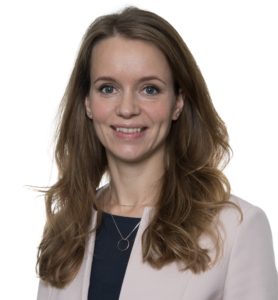
Reminder: Tomorrow is the first Tuesday of the month, and Elisabeth from BTO will be here from 12 o´clock – at your service!

Reminder: Tomorrow is the first Tuesday of the month, and Elisabeth from BTO will be here from 12 o´clock – at your service!
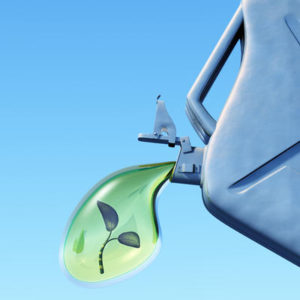
Copyright: Colourbox
Wednesday 8th of February, 12.00 – 16.00
Venue: Høgskulen på Vestlandet, Campus Kronstad, Room D113
12:00 Informal lunch
12:40 Welcome, by Richard John Grant, HVL
12:45 Biofuels: The whys and whynots 4Norway, and the howmuch, Gunnar S Eskeland, NHH
13:10 The spark plug, Lars Magne Nerheim, HVL
13:35 Bio oil, Geir H. Ingeborgrud, Eco-1
14:30-14:55 Research perspectives on biofuels, Tanja Barth, UiB
14:55 The European strategy on biofuel, Tor Ivar Eikaas, Norges Forskningsråd
15:20 Norwegian use of aviation biofuel, Avinor
Applying NMR spectroscopy and Magnetic Resonance Imaging, researchers at our department (Christian Totland, John Georg Seland and Willy Nerdal) and at Høgskulen på Vestlandet (Signe Steinkopf) document how reduction in marine omega-3 in farmed salmon affects salmon fillet features, right down at the molecular level. The study shows that carbon magnetic resonance spectroscopy direct on the fish meat can quantify the most relevant fatty acids within 40 minutes without the use of chemicals such as chloroform. In 1990, omega-3 in farmed salmon was predominantly marine fatty acids while there are now roughly equal levels of omega-3 from plants and marine sources. 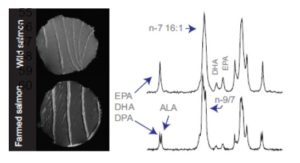 MR images show differences in texture between wild and farmed salmon, where wild salmon have narrower lines of fat tissue compared to farmed salmon. In addition, the muscle tissue of farmed salmon shows buildup of fat, known as marbled fat. The softer consistency of farmed salmon can be viewed in conjunction with fat profile.
MR images show differences in texture between wild and farmed salmon, where wild salmon have narrower lines of fat tissue compared to farmed salmon. In addition, the muscle tissue of farmed salmon shows buildup of fat, known as marbled fat. The softer consistency of farmed salmon can be viewed in conjunction with fat profile.
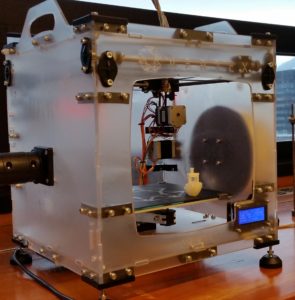 På tampen av 2016 ble det kjøpt inn en 3D-skriver (Velleman Vertex K8400) til petroleum- og kolloidkjemi-laben i 4. etasje. Skriveren kan gi oss reservedeler til gamle instrumenter hvor deletilgangen er dårlig. Den er også egnet til å lage annet labutstyr tilpasset våre behov. Skriveren er nå montert og noen testutskrifter har blitt kjørt med stor suksess.
På tampen av 2016 ble det kjøpt inn en 3D-skriver (Velleman Vertex K8400) til petroleum- og kolloidkjemi-laben i 4. etasje. Skriveren kan gi oss reservedeler til gamle instrumenter hvor deletilgangen er dårlig. Den er også egnet til å lage annet labutstyr tilpasset våre behov. Skriveren er nå montert og noen testutskrifter har blitt kjørt med stor suksess.
Til høyre er et sentrifugehode som påmontert vår Black&Decker-maskin gir en relativ sentrifugalkraft på nesten 50000 (rcf = 49700 × g), adskillig mer enn hva vår benksentrifuge kan klare (~20000 × g).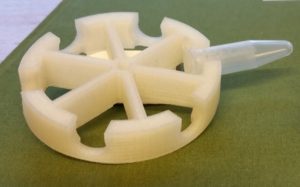
Skriveren kan skrive ut gjenstander på ca. 20cm × 20cm × 20cm. Skriveren har ett skrivehode, som legger ut en streng av smeltet polymer, lag på lag, minste lagtykkelse er ca 50µm.
For å skrive ut en gjenstand må vi ha en 3d-modell. Denne kan lages selv i programmer som Sketchup og tilsvarende. Det finnes også mange modeller på nettet som man kan hente ned gratis, for eksempel fra Thingiverse. Programmer som fulgte med skriveren gjør modellen om til en skriverkode som skriveren forstår. Koden kan legges inn på et SD-kort, skriveren må ikke være tilkoblet PC for å skrive ut.
Ta kontakt med Tore Skodvin!
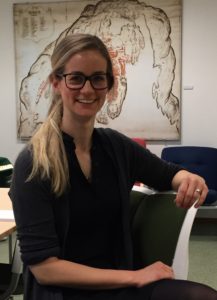 Last Friday, Camilla Løhre successfully defended her thesis, titled «The effect of input material pretreatment on product yield
Last Friday, Camilla Løhre successfully defended her thesis, titled «The effect of input material pretreatment on product yield 
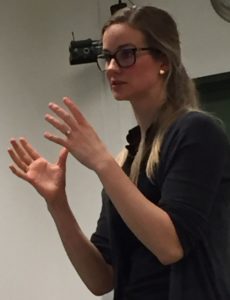 and composition of bio-oils from LtL solvolysis. A continuous process for organosolv fractionation of lignocellulosic biomass and solvolytic conversion of lignin.» Camilla seized the opportunity (not the opponent) with both hands and came out victorious.
and composition of bio-oils from LtL solvolysis. A continuous process for organosolv fractionation of lignocellulosic biomass and solvolytic conversion of lignin.» Camilla seized the opportunity (not the opponent) with both hands and came out victorious.
Room 3069 Time: Thursday, February 16th 2017, starting at 12:15 12:15-13:00: Introductory lecture: “High throughput solutions for Chemistry, Materials Research and Biologics Formulation Development” 13:00-13:15: Coffee break 13:15-14:00: Presentation and discussion of some specific case study examples from various fields of applications. In this session, the participants will have the opportunity to discuss with the speakers about technical solutions for specific needs and applications. The priority list of the specific topics would be organized according to the participants’ interests and requirements. Please send by email (Giovanni.Occhipinti@uib.no) a short description of the topic(s) you are most interested by Friday, February 3rd 2016 at 12:00.
The Engineering school of Organic and Inorganic Chemistry (ESCOM) in Compiègne, France, is offering internship for a chemistry candidate (undergraduate or graduate students) with strong interest in green chemistry. Basic knowledge of nanomaterials would be appreciated.  Contact: Kristin Torp Skogedal, Erasmus Coordinator, Division of Student Affairs, at kristin.skogedal@adm.uib.no
Contact: Kristin Torp Skogedal, Erasmus Coordinator, Division of Student Affairs, at kristin.skogedal@adm.uib.no
January 16-17 will be days to remember for the Department of Chemistry. Modern instrumentation for flow synthesis was installed and a bunch of enthusiastic users from the section of Organic Synthesis and Medicinal Chemistry received training on the new system.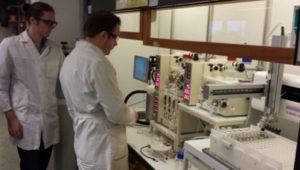
This installation represents a leap from equipment invented in the era of the alchemy (the glass flask) into modern computerized flow-chemistry instrumentation. It is a highly modular and versatile system composed by several feeding pumps, reactor manifolds and thus also various types of reactors. The control and monitoring program also allows combining in-house developed and third party equipment. The instrumentation is designed, produced and delivered by Vapourtec.
Particle therapy has emerged as a promising treatment alternative for many cancer patient groups and the number of facilities offering this treatment is rapidly increasing worldwide. In Norway, a planning process for establishing this treatment has been ongoing for several years and 1-2 centers are planned to be operational within 2022. For more details; Today - 12.15, "The triplet", = room 3069. Coffee, tea, and cookies will be served. Welcome! Knute the Brute
Foredragsholder: Daniel Lokshtanov, professor, Universitetet i Bergen
Er det vanskeligere å finne en nål i en høystakk, enn å bekrefte at en nål faktisk er en nål? Er det lettere å finne høy i en høystakk med bind for øynene enn uten? Hvis man trenger å finne en nål i en høystakk, trenger man å lete gjennom hele høystakken? Disse spørsmålene er, utrolig nok, noen av de største og viktigste ubesvarte spørsmålene i informatikk, hvis den som leter er en datamaskin, nålen er en løsning på et beregningsproblem og høystakken er alt som ser ut som en løsning, men ikke er det.

7. februar 2017. Tidspunkt: 19:00 – 22:00. Nansensenteret på Marineholmen, Thormøhlens gate 47.